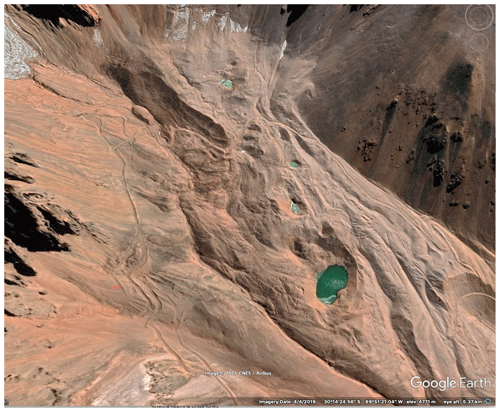Comment on “Ice content and interannual water storage changes of an active rock glacier in the dry Andes of Argentina” by Halla et al. (2021)
Recently published work on water preservation in Chile assumes that “permafrost” (cryogenic) rock glaciers are dominant. Melt pond development shows that rock glaciers are glacier-derived (“glacigenic”) rather than of permafrost origin.
Halla et al. (2021) make a useful contribution to estimating the water content of rock glaciers at “Dos Lenguas” in Chile [-30.2465,-69.7867]. Note that locational data are available as decimal latitude–longitude values as tuples in the following format: [lat,long]. However, their interpretation (Fig. 10) relies on the assumption that it is a “talus rock glacier”, a body of creeping permafrost unrelated to any glacier. Although commonly held, this origin is not supported by rheology (Whalley and Azizi, 1994). Further, the Dos Lenguas (DL) site shows no rock glacier formation in or from the extensive local talus. The glacier ice core (“glacigenic”) model better explains formation and flow (Whalley and Azizi, 2003). Gruben rock glacier, taken to be a “typical” permafrost-derived rock glacier, is actually of Little Ice Age origin and is glacier-ice cored (Whalley, 2020). At DL, a small glacier formed in a south-facing hollow then covered by insulating weathered rock debris. To the west (6.5 km) of DL, there are several rock glaciers where glacier ice could collect and be buried. The largest of these (Fig. 1) lies below a glacier and debris-covered glacier. Over the last 15+ years, glacier melting has produced substantial surface pools. Some 16 km from DL, the Tapado–Las Talas glacier–rock-glacier complex [-30.153,-69.916] has similar features. Monnier et al. (2014) show a debris-covered glacier with melt (thermokarst) pools merging with a rock glacier, itself overriding a moraine sequence. Schaffer et al. (2019) considered this a complete rock glacier sequence below the Tapado glacier with the debris-covered section being “glacigenic” (their Fig. 3). The Tapado glacier [-30.1510,-69.9246] is now separated from a debris-covered glacier [-30.1548,-69.9212] below which is a glacigenic rock-glacier component [-30.1567,-69.9128]. The neighbouring Las Tolas rock glacier [-30.1541,-69.9114] was viewed as “cryogenic” (permafrost-periglacial) by Schaffer et al. (2019). There is no visible glacier component in the cirque above the rock glacier, although Google Earth images (2017) show copious snow collection and crevasse features (noted by Schaffer et al., 2019) on the steepest section. As with the rock glaciers west of DL, the simplest explanation for all these features is glacigenic, i.e. glacier derived. The seismic traces used by Monnier et al. (2014) and evidence from Schaffer et al. (2019) to differentiate between glacigenic and cryogenic components are probably due to the complex relationships of glacier-ice–snow and debris supply.

Figure 1A glacigenic rock glacier centred on the prominent surface melt pool at [-30.2414,-69.8541] shows ablation of massive, glacier-derived, ice under a debris cover. These melt pools can be traced from the uppermost part of the rock glacier through to near the snout and are persistent over several years of Google Earth imagery. A permafrost (talus-derived) feature would show “isovolumetric” melting of ice in pore spaces and thus have a rather different water storage capability from a glacier core. © Google Earth/CNES/Airbus.
In summary, the geophysical data supplied by Milana and Güell (2008) and Halla et al. (2021) are useful in the development of models to estimate water storage potential. However, their interpretation of rock glaciers as “permafrost” (“cryogenic” or “cryo-conditioned”) features in mountain environments neglects the evidence in the literature of them being glacier ice-cored features as shown by the development of surface meltwater ponds on several rock glaciers in the dry Andes.




